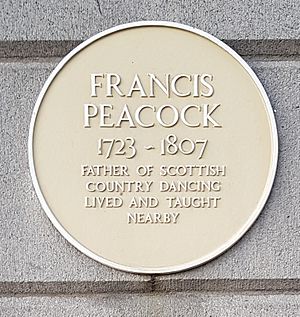Francis Peacock facts for kids
Quick facts for kids
Francis Peacock
|
|
|---|---|
| Born | 1723 |
| Died | 26 June 1807 (aged 83–84) |
| Occupation | dance instructor, musician |
|
Notable work
|
Sketches Relative to the History and Theory, but More Especially to the Practice of Dancing |
Francis Peacock (born 1723, died 26 June 1807) was a Scottish dance teacher and musician. Many people call him the "Father of Scottish country dancing."
Francis Peacock's Life
Francis Peacock might have been born in York. He learned dancing from a famous teacher named George Desnoyer. George Desnoyer later became the dance teacher for King George III.
In 1742, people in Aberdeen asked their town council for a good dance teacher. They felt the town needed someone to teach their children. A few years later, James Stuart was hired as the dance master. (A "dance master" was an old name for a dance teacher.) But he didn't seem to work out. So, in 1746, the council looked for a new teacher. They wanted someone "of sober, discreet and moral character."
John Dawney, a dance master from Edinburgh, suggested Francis Peacock. Francis was also living in Edinburgh at the time. On February 14, 1747, the town council chose 23-year-old Peacock. He became the official and only dance master of Aberdeen. He earned seven shillings per student each month. He also received money to arrange music for the lessons.
Dance and Music in Aberdeen
In Aberdeen, Francis Peacock started the first dance school. He also helped create the Aberdeen Musical Society. He founded this society with doctor John Gregory, organist Andrew Tait, and music copyist David Young. For almost 60 years, Peacock was a director for the society. He sometimes played the violin for them too. Money made from their private concerts went to help charities.
Peacock taught dancing in Aberdeen for five decades, which is 50 years! Many of his students were from Scottish noble families. Peacock strongly believed that dancing was important for young people. He thought it helped them learn good manners and grace. He wrote that dancing helps people become "agreeable" in public and private. He believed it gave a "graceful and elegant ease" to those who practiced it.
He is especially known for his eight-volume book about dance. It was called Sketches Relative to the History and Theory, but More Especially to the Practice of Dancing. This book was published in 1805. It was one of the first books to talk about the history of dance. He dedicated it to Jane Gordon, Duchess of Gordon. In his book, he used traditional Gaelic names for dances. But he also used classical French ballet terms.
Francis Peacock had other talents too. He painted portrait miniatures, which are very small portraits. He also wrote music. One of his songs was played when King George III was crowned in 1761. He played the violin with the Aberdeen Musical Society. He also published a music book called Fifty Favourite Airs for the Violin in 1762.
Family Life
On February 15, 1748, Francis Peacock married Ellen (or Helen) Forbes. They were married at St Nicholas's Church in Aberdeen. Ellen passed away in 1804. They had five children together: Elizabeth, Jannet, John, George, and Thomas.
His Legacy
Francis Peacock was also a kind person who helped others. He donated the money from his 1805 book, about £1,000, to the Aberdeen Lunatic Asylum. (This hospital is now called Royal Cornhill Hospital.) He also left a lot of money to charity in his will.
Today, you can find a special plaque on Castle Street in Central Aberdeen. It marks where his old dance school used to be. A street in eastern Aberdeen, called Peacock's Close, is named after him.


